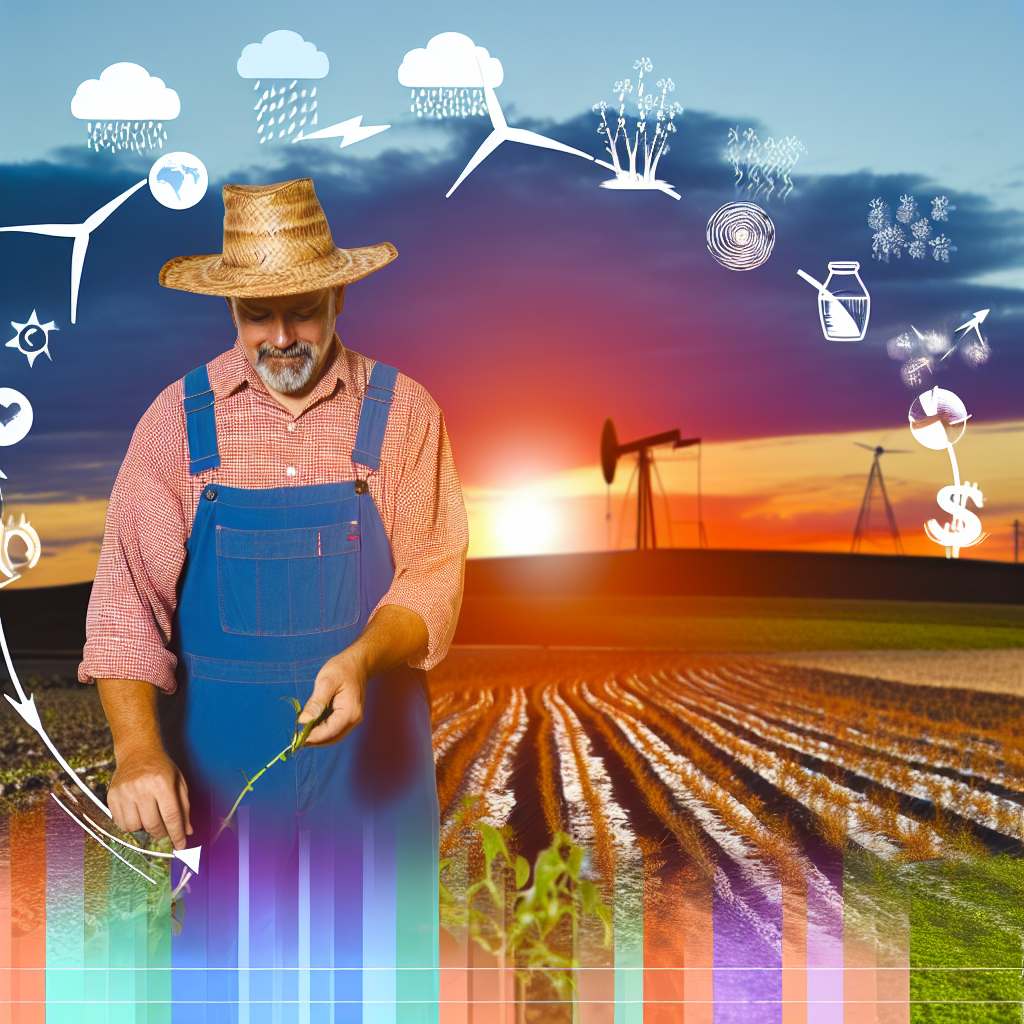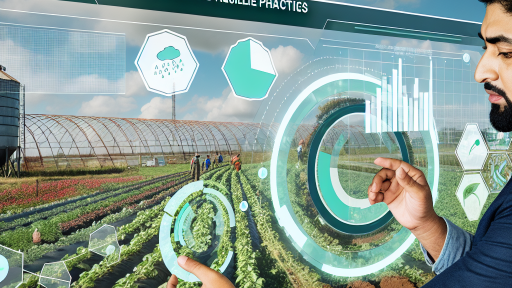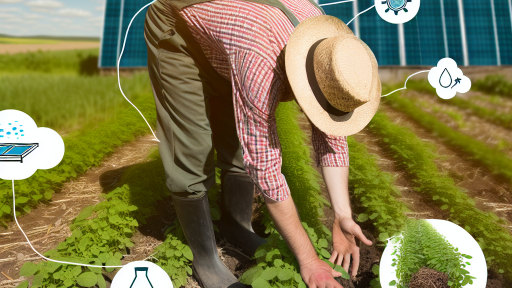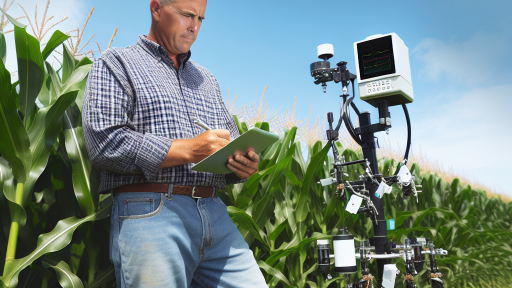Understanding Climate Change and Its Impact on Agriculture
Overview of Climate Change
Climate change refers to long-term alterations in temperature and typical weather patterns.
Scientists observe rising global temperatures and shifting precipitation patterns.
These changes result from increased greenhouse gas emissions from human activities.
Agriculture plays a significant role in these emissions but also faces severe challenges.
Effects on Crop Yields
Changes in temperature directly affect plant growth and crop yields.
Crops like wheat and maize are particularly sensitive to these temperature shifts.
Moreover, extreme weather events can damage crops and reduce harvests.
Farmers must adapt to these challenges to maintain productivity.
Impacts on Soil Quality
Climate change influences soil health through erosion and nutrient depletion.
Increased rainfall can lead to waterlogged soils and reduced aeration.
Consequently, soil microbiomes and fertility may suffer, leading to lower yields.
Water Availability
Changes in precipitation patterns affect water availability for irrigation.
Many regions face drought, making water management critical for farmers.
Therefore, efficient irrigation systems become increasingly important.
Pests and Diseases
Warmer temperatures enable pests and diseases to thrive in new regions.
Transform Your Agribusiness
Unlock your farm's potential with expert advice tailored to your needs. Get actionable steps that drive real results.
Get StartedThis expansion poses additional risks to crops and livestock.
Farmers must implement integrated pest management strategies to counter these threats.
Socio-Economic Implications
Climate change also has socio-economic implications for farming communities.
Shifts in crop viability can affect local economies reliant on agriculture.
Moreover, food security becomes a pressing concern as production decreases.
Communities may need to adapt their farming practices and diversify crops.
Assessing Soil Health and Using Regenerative Practices
Understanding Soil Health
Soy health is crucial for sustainable farming.
Healthy soil promotes strong crop growth.
Farmers should regularly assess their soil conditions.
This assessment can include testing for pH, nutrients, and organic matter.
Healthy soil supports beneficial organisms.
It also improves water retention and drainage.
Implementing Regenerative Practices
Regenerative practices help restore and enhance soil health.
These methods can increase resilience in changing climates.
Farmers should consider crop rotation as a strategy.
Rotating crops breaks pest and disease cycles.
This practice enhances soil biodiversity and fertility.
Cover Cropping
Cover crops offer numerous benefits to soil health.
They prevent erosion and suppress weeds.
Additionally, they contribute organic matter to the soil.
Cover crops also improve soil structure and health.
Conservation Tillage
Conservation tillage reduces soil disturbance.
This method protects soil structure and its microbial community.
It helps retain moisture and decreases erosion.
Showcase Your Farming Business
Publish your professional farming services profile on our blog for a one-time fee of $200 and reach a dedicated audience of farmers and agribusiness owners.
Publish Your ProfileFarmers can gradually transition to reduced tillage methods.
Utilizing Organic Amendments
Organic amendments bolster soil health significantly.
Compost, manure, and green manures enrich the soil.
These materials provide essential nutrients for plants.
They also enhance soil structure and microbial activity.
Monitoring and Adapting Practices
Regular monitoring helps assess the effectiveness of practices.
Farmers can adjust approaches based on observed results.
Gathering data on weather and soil health enhances decision-making.
This flexibility allows timely responses to changing conditions.
Crop Diversification as a Strategy for Resilience
Importance of Crop Diversification
Crop diversification helps farmers adapt to changing climates.
It reduces risks associated with climate variability and market fluctuations.
Furthermore, diverse crops can improve soil health and ecosystem resilience.
Types of Crop Diversification
Farmers can implement various types of crop diversification.
Intercropping involves growing multiple crops in proximity.
Rotational cropping allows farmers to switch crops seasonally.
These practices enhance biodiversity and reduce pest pressure.
Benefits of Crop Diversification
Crop diversification offers multiple benefits for farmers.
- It increases overall farm productivity.
- Diverse crops can provide multiple sources of income.
- It enhances food security for local communities.
Implementation Strategies
Farmers should consider local conditions when diversifying crops.
Conducting soil tests can guide crop selection.
Participating in farmer cooperatives fosters knowledge exchange.
Additionally, accessing local markets can support diversified crops.
Challenges of Crop Diversification
Despite its benefits, crop diversification can pose challenges.
Farmers may face initial costs for seeds and equipment.
They also need to acquire new knowledge on crop management.
However, these challenges can be mitigated through training programs.
Gain More Insights: Innovative Water Recycling Methods in Agriculture
Implementing Water Conservation Techniques in Farming
Importance of Water Conservation
Water conservation plays a crucial role in sustainable farming.
Farmers must adapt to changing climate conditions.
Effective water management enhances crop yield and quality.
Moreover, it reduces costs associated with water use.
Rainwater Harvesting
Rainwater harvesting is an effective technique for farmers.
This method collects rainwater from roofs and surfaces.
Subsequently, it stores water for future irrigation needs.
Farmers can utilize tanks or underground reservoirs.
Implementing this technique ensures water availability during dry spells.
Drip Irrigation Systems
Drip irrigation systems deliver water directly to plant roots.
This method minimizes water wastage significantly.
Additionally, it allows targeted application of nutrients.
Farmers can customize systems to fit their needs and crops.
As a result, crop health improves, and water usage decreases.
Showcase Your Farming Business
Publish your professional farming services profile on our blog for a one-time fee of $200 and reach a dedicated audience of farmers and agribusiness owners.
Publish Your ProfileSoil Moisture Management
Monitoring soil moisture is vital for effective irrigation.
Farmers should use sensors to measure moisture levels.
This information helps them determine when to irrigate.
Consequently, it prevents overwatering and promotes healthier plants.
Furthermore, healthy soil retains moisture better over time.
Cover Cropping
Cover cropping is another impactful strategy for water conservation.
This practice involves planting cover crops during off-seasons.
These crops protect soil from erosion and improve its structure.
Additionally, they enhance water retention in the soil.
Overall, cover cropping supports sustainable farming practices.
Mulching Techniques
Using mulch helps reduce water evaporation from the soil.
Organic materials such as straw or wood chips work effectively.
Mulching also suppresses weed growth and enhances soil health.
Farmers should consider applying a thick layer of mulch.
This technique further benefits plant growth and moisture retention.
Learn More: Climate-Smart Farming: Essential Adaptation Strategies
Adopting Sustainable Pest Management Practices
Understanding Sustainable Pest Management
Sustainable pest management minimizes environmental impacts.
It focuses on controlling pests with the least harm to ecosystems.
Farmers use a variety of techniques to manage pest populations.
Integrating Cultural Practices
Cultural practices play a vital role in pest management.
Crop rotation disrupts pest life cycles effectively.
Cover cropping can protect soil and reduce pest populations.
Moreover, adjusting planting dates can avoid peak pest activity.
Utilizing Biological Control Methods
Biological control leverages natural predators and parasites.
Introducing beneficial insects can help control pest populations.
Farmers can also conserve existing beneficial species on their land.
This method reduces reliance on chemical pesticides.
Implementing Mechanical and Physical Controls
Mechanical controls include traps and barriers.
Row covers can protect plants from insect damage.
Additionally, hand-picking pests can be effective in small-scale operations.
Farmers can combine these methods to enhance effectiveness.
Applying Chemical Control Wisely
When necessary, chemical controls should be applied responsibly.
Farmers must choose targeted pesticides to minimize side effects.
Timing applications according to pest life cycles ensures maximum impact.
Moreover, integrating chemicals with other methods enhances sustainability.
Monitoring and Evaluation
Regular monitoring is crucial for effective pest management.
Farmers should assess pest populations continuously.
Evaluating outcomes will help refine management practices over time.
Data collection can guide future pest control strategies.
Delve into the Subject: Renewable Energy Adoption in Sustainable Farming
Showcase Your Farming Business
Publish your professional farming services profile on our blog for a one-time fee of $200 and reach a dedicated audience of farmers and agribusiness owners.
Publish Your Profile
The Role of Technology and Precision Agriculture in Adaptation
Understanding Precision Agriculture
Precision agriculture maximizes productivity while minimizing waste.
This approach uses data analysis to enhance farming efficiency.
Farmers adopt various technologies, such as GPS and sensors, to monitor crops.
Consequently, they can make informed decisions based on real-time data.
Technological Innovations
Innovations play a crucial role in helping farmers adapt to climate changes.
Drones assist in surveying fields and assessing crop health from the sky.
Additionally, IoT-enabled devices provide continuous monitoring of soil conditions.
These tools enable farmers to respond quickly to environmental shifts.
Data-Driven Decision Making
Data analytics transform how farmers manage their operations.
Farmers can track weather patterns and predict agricultural needs.
This predictive capability leads to better resource allocation and planning.
Moreover, data insights help identify best planting and harvesting times.
Sustainable Practices with Technology
Technology supports sustainable farming practices effectively.
For example, precision irrigation reduces water usage significantly.
Furthermore, automated systems improve efficiency and decrease labor costs.
Farmers can apply fertilizers more accurately, reducing environmental impact.
Collaborative Efforts in Technology Adoption
Collaboration among farmers, tech companies, and researchers is essential.
By sharing knowledge and resources, they can drive innovation in agriculture.
Moreover, community-based training programs can enhance skills in new technologies.
This collaboration ultimately fosters resilience against climate challenges.
See Related Content: Renewable Energy Options for Climate-Smart Farms
Building Stronger Agricultural Communities through Collaboration
The Importance of Community Engagement
Collaboration among farmers enhances resilience in changing climates.
Engaged communities share knowledge and resources effectively.
Furthermore, local networks provide emotional and logistical support.
Establishing Collaborative Networks
Farmers can create cooperatives to improve bargaining power.
These cooperatives can facilitate joint purchasing of supplies.
By sharing equipment, farmers reduce operational costs significantly.
Implementing Educational Programs
Educational programs empower farmers with crucial insights.
Workshops on sustainable farming techniques are essential.
Online resources also offer accessible training materials.
Sharing Best Practices
Farmers benefit from exchanging successful strategies.
Community meetings can serve as platforms for discussion.
Additionally, online forums facilitate ongoing collaboration.
Leveraging Technology for Collaboration
Technology enhances communication among agricultural stakeholders.
Farmers can use apps to share data on weather and soil conditions.
These tools foster informed decision-making in real-time.
Building Relationships with Local Organizations
Collaboration with local organizations can broaden support networks.
Non-profits often provide technical assistance and resources.
These partnerships can also increase access to funding opportunities.
Encouraging Public Policy Advocacy
Farmers together can influence agricultural policy effectively.
Showcase Your Farming Business
Publish your professional farming services profile on our blog for a one-time fee of $200 and reach a dedicated audience of farmers and agribusiness owners.
Publish Your ProfileAdvocacy efforts can lead to more supportive regulations.
Collective voices are more persuasive in policy discussions.
Strengthening Agricultural Communities
Through collaboration, farmers strengthen their communities.
They enhance resilience against the challenges posed by climate change.
Ultimately, building strong networks leads to sustainable agriculture.
Financial Planning and Insurance Options for Farmers Facing Climate Risks
Understanding Climate Risks
Farmers face various climate risks that threaten their livelihoods.
These risks include droughts, floods, and extreme temperatures.
To manage these challenges, farmers must first understand the potential impacts on their operations.
Detailed assessments can help identify vulnerabilities in their farming practices.
Building a Financial Safety Net
Establishing a financial buffer can protect farmers from unforeseen events.
Farmers should consider saving funds specifically for emergencies.
Additionally, setting aside savings for future investments is essential.
Farmers can also explore microloans for immediate capital needs.
Insurance Options for Risk Management
Insurance serves as a key tool for mitigating financial losses from climate-related disruptions.
Crop insurance protects farmers against yield losses from climatic events.
Farmers should assess different policies to find the best coverage.
Livestock insurance can also safeguard farmers from unexpected animal losses.
Government and Community Resources
Farmers can access numerous government programs designed to support them during climate emergencies.
These programs often provide subsidies for insurance coverage.
Community organizations may also offer resources and training on climate adaptation.
Networking with local agricultural associations can provide valuable information.
Implementing Sustainable Practices
Farmers should adopt sustainable practices to reduce climate vulnerability.
Crop rotation can enhance soil health and resilience against pests.
Cover crops may prevent soil erosion and retain moisture during dry spells.
Additionally, water conservation techniques can help manage irrigation needs more efficiently.
Investing in Technology
Modern technology offers innovative solutions for climate adaptation.
Farmers can utilize precision agriculture tools to optimize resource use.
Drone technology can assist in monitoring crop health and soil conditions.
Investing in climate forecasting services can also improve decision-making.
Consulting Financial Advisors
Consulting with financial advisors can help farmers navigate complex financial landscapes.
Experts can provide tailored advice on financial planning and insurance options.
Regularly reviewing financial strategies allows farmers to adapt to changing conditions.
Engaging with an advisor who understands agricultural risks can be particularly beneficial.
Additional Resources
Climate Change Impacts on Agriculture and Food Supply | US EPA




